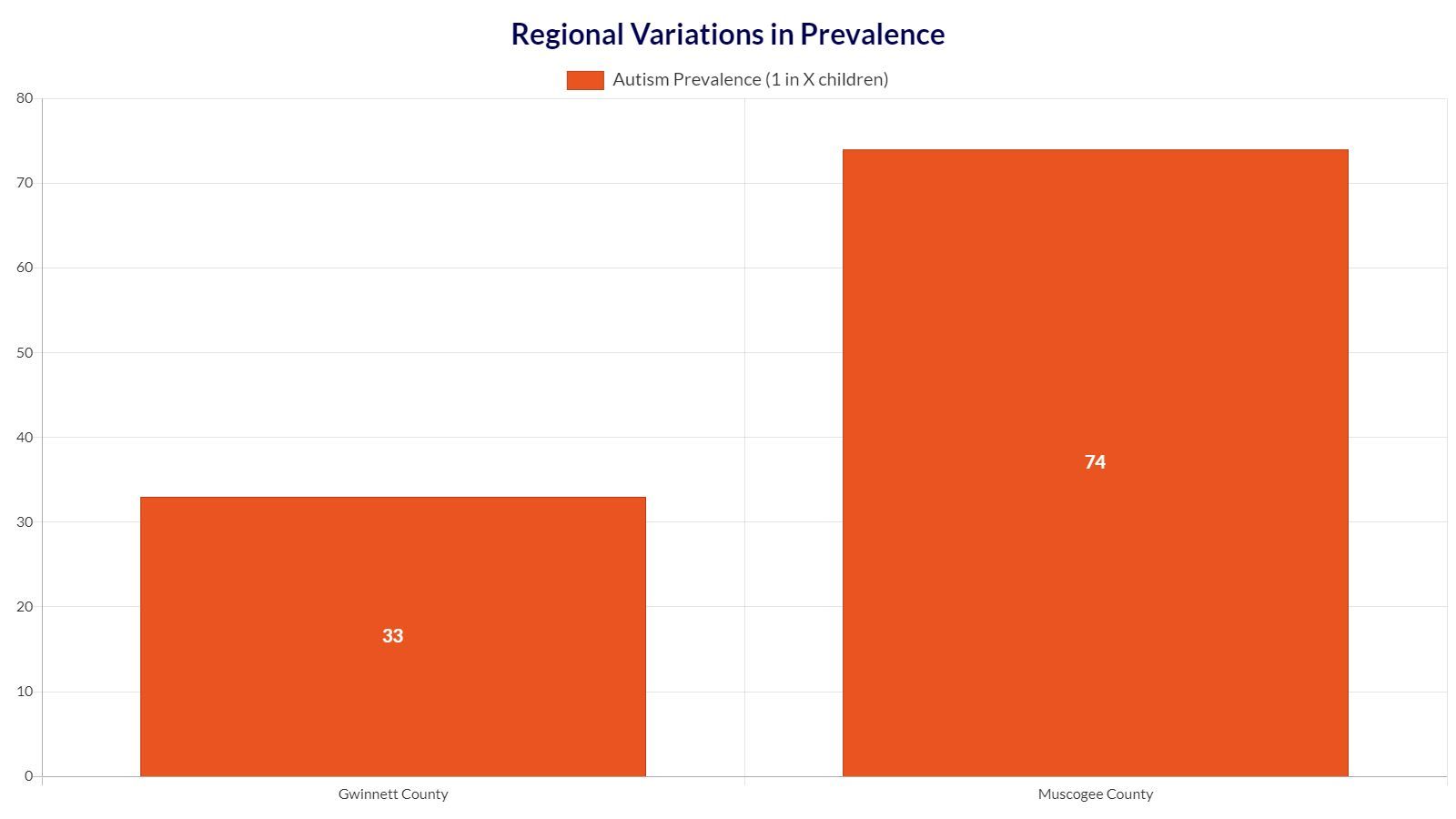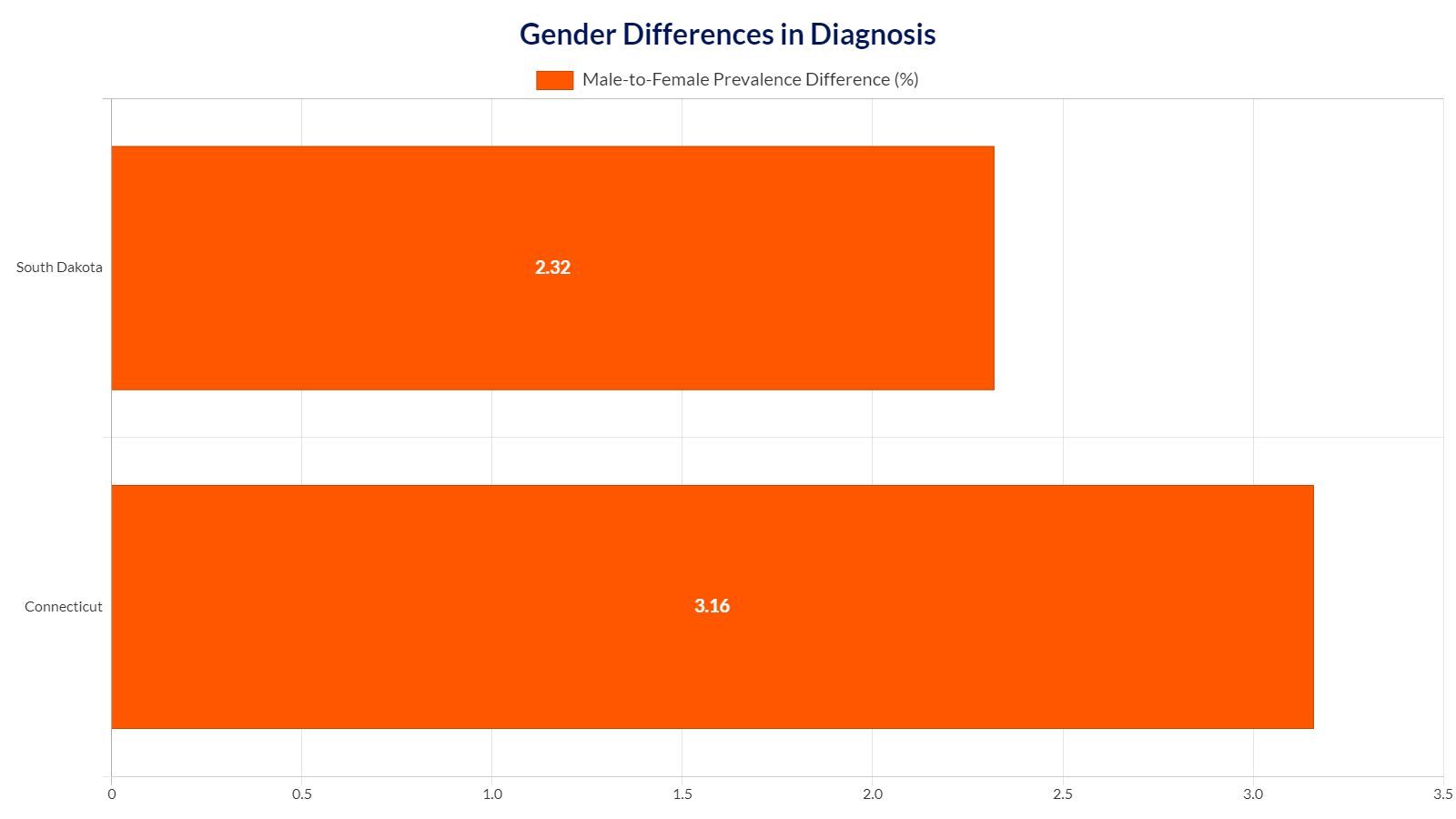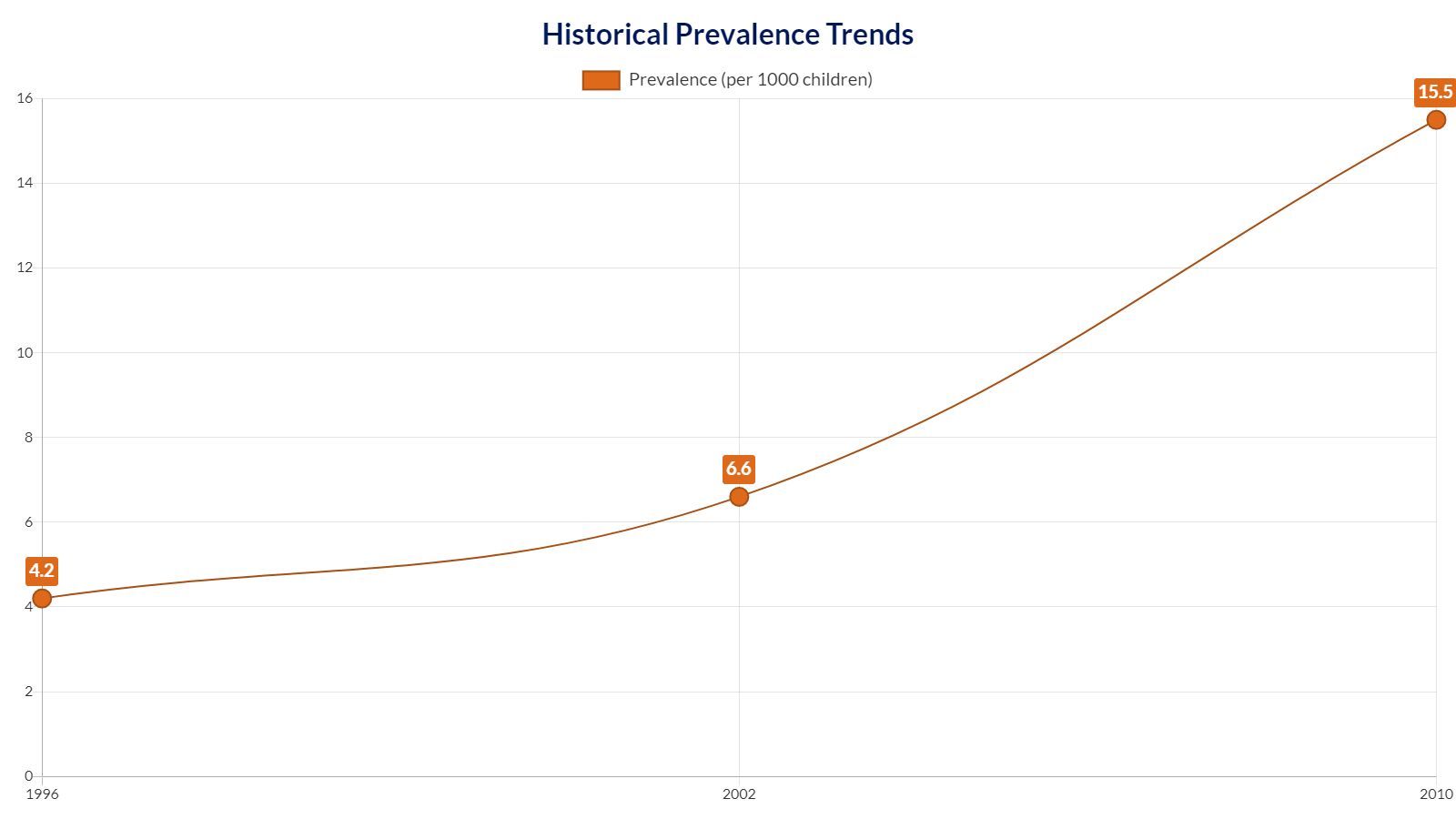The Autism Puzzle: Unraveling the Prevalence in Georgia

Laura NG, MA BCBA
Clinical Operations Manager
Autism Prevalence in Georgia
2020 Statistics and Trends
In 2020, Georgia observed a prevalence of Autism Spectrum Disorder (ASD) that aligns with national trends. According to the Metropolitan Atlanta Developmental Disabilities Surveillance Program (MADDSP), approximately 2.5% of 8-year-old children were identified with ASD in Georgia, mirroring the average percentage identified across various communities in the United States where the CDC tracked ASD among 8-year-olds that year. This statistic is pivotal for understanding the current landscape of autism in the state and underscores the importance of continued monitoring and support for individuals with ASD.
The
data from Georgia also offers insight into the age of diagnosis, revealing that children identified with ASD received a comprehensive developmental evaluation by 3 years of age, with IQ data available for 72% of the cases. Furthermore, there is a notable increase in the likelihood of receiving an ASD diagnosis or ASD special education classification by 48 months of age for children who are 4 years old, which is 1.4 times higher compared with children who are 8 years old.
| Age Group | Likelihood of Receiving an ASD Diagnosis by 48 Months |
|---|---|
| 4 Years Old | 1.4 times |
| 8 Years Old | 1 time |
Racial Disparities in Autism Diagnosis
Racial disparities in autism diagnosis are a concerning trend in Georgia. Black children were found to be 1.5 times more likely to be identified with ASD compared to White children among the 8-year-olds surveyed. Other racial and ethnic groups in Georgia were identified with ASD at rates 2 or more times as likely compared to White children at age 4 years. These disparities highlight the need for more equitable approaches to ASD diagnosis and access to care.
The implications of these findings are significant, as they point to potential barriers to early diagnosis and intervention for certain racial groups. Addressing these disparities is crucial in ensuring that all children with ASD receive the support they need, which is why the exploration of
autism diagnosis in Georgia and promoting
autism awareness in Georgia are critical steps toward achieving this goal.
| Racial Group | Likelihood of Being Identified with ASD Compared to White Children |
|---|---|
| Black | 1.5 times |
| Other | 2 or more times |
Understanding the prevalence and trends of autism in Georgia is essential for tailoring interventions, allocating resources, and conducting autism research in Georgia. It is also an important comparative measure for exploring autism statistics in Nebraska and beyond, as geographic and demographic factors can influence the identification and support of individuals with ASD.
Early Diagnosis and Intervention
One of the most critical aspects of managing Autism Spectrum Disorder (ASD) is the timeliness of diagnosis and intervention. In the state of Georgia, efforts are being made to ensure that children are screened and supported as early as possible.
Importance of Early Evaluation
An early diagnosis of Autism Spectrum Disorder is widely acknowledged as a crucial step in the development and well-being of children affected by the condition. By age 2, a diagnosis can be considered reliable when conducted by an experienced professional, according to the Georgia Department of Public Health. Early evaluation is especially important for children at a higher risk due to factors such as preterm birth, low birth weight, or having a sibling with ASD.
Screening for developmental delays should be a routine part of early childhood care. With over 3,500 children between the ages of 18 and 24 months screened using the MCHAT-R/F across Georgia, the state is taking significant steps to identify ASD early. The autism diagnosis in Georgia page provides more detailed information on the diagnostic process.
Impact of Early Diagnosis on Treatment
Early diagnosis often leads to early intervention, which can have a profound impact on the treatment and management of autism. The Georgia Autism Initiative is a testament to this approach, offering early intervention, family coaching, and support, along with transition planning and provider training for infants and youth with ASD from birth to 21 years of age.
Early intervention services can include speech therapy, occupational therapy, and Applied Behavior Analysis (ABA) therapy, which are designed to improve social, communication, and learning skills. These services are more effective when started at a young age, as they can capitalize on the brain's plasticity and help children with ASD to reach their full potential.
The autism awareness in Georgia initiative emphasizes the importance of community awareness and support for families dealing with ASD. Furthermore, ongoing autism research in Georgia continues to improve understanding and treatment of ASD.
It is crucial for parents, family members, ABA therapists, educators, and school personnel to be informed about the significance of early diagnosis and intervention in ASD. By doing so, they can ensure children with ASD in Georgia receive the necessary support to lead fulfilling lives. For comparative insights, one might also look at autism statistics in Nebraska.
Geographic Disparities
Autism Spectrum Disorder (ASD) prevalence is not uniform across different regions. In Georgia, there are noticeable disparities in autism rates that reflect a complex interplay of factors including access to healthcare, awareness programs, and diagnostic services.
Regional Variations in Prevalence
Georgia exhibits significant regional variation in autism prevalence. According to data from the
CDC, Gwinnett County has the highest identified prevalence of ASD with 1 in 33 children, while Muscogee County has a notably lower prevalence with 1 in 74 children. This disparity may be influenced by socio-economic factors, availability of diagnostic and intervention services, and community awareness about autism.

These differences suggest a need for localized investigation to understand the underlying causes and to ensure equitable access to resources for all affected families.
Localized Strategies for Support
To respond to the regional disparities in autism prevalence, Georgia must implement localized strategies that cater to the specific needs of each community. This includes:
- Increasing Awareness: Raising awareness about ASD in lower prevalence areas might lead to more accurate diagnoses and support. Efforts could involve community workshops, educational campaigns, and ASD training for healthcare professionals, which align with
autism awareness in Georgia initiatives.
- Improving Access to Diagnostic Services: Enhancing the availability of diagnostic services in underserved areas can ensure early identification and intervention. This involves not only establishing more diagnostic centers but also training local pediatricians in early ASD detection. More information about autism diagnosis can be found at
autism diagnosis in Georgia.
- Tailored Intervention Programs: Developing intervention programs that are tailored to the specific demographic and cultural needs of each region is essential. This could include language-specific resources and culturally sensitive practices.
- Research and Data Collection: Conducting local research to understand why certain areas have higher or lower prevalence rates can inform targeted interventions. Updated findings and ongoing studies can be reviewed through autism research in Georgia.
By recognizing and addressing these geographic disparities, Georgia can take a crucial step toward ensuring that all children with ASD, regardless of where they live, have the opportunity to reach their full potential. Cross-referencing autism statistics in Nebraska can also provide a comparative perspective on how different states are tackling similar challenges.
Gender Disparities in Autism
Exploring the autism prevalence in Georgia reveals significant disparities between genders. These disparities not only highlight the differences in prevalence rates but also shed light on the challenges of diagnosing autism spectrum disorder (ASD) in different genders.
Male vs. Female Prevalence
Boys in Georgia are significantly more likely to be diagnosed with ASD compared to girls. The prevalence rate of ASD in boys is approximately 2.96%, which is nearly four times the rate in girls, which stands at 0.75%. This discrepancy is consistent with national trends, where the estimated ASD prevalence for females is 0.86%, while it is much higher for adult males at 3.62%.
Here is a table illustrating the gender disparity in autism prevalence:
| State | Male Prevalence (%) | Female Prevalence (%) | Male-to-Female Prevalence Ratio |
|---|---|---|---|
| Georgia | 2.96 | 0.75 | ~3.94 |
| National Average | 3.62 | 0.86 | Varies by State |
These figures underscore the importance of understanding and recognizing the factors contributing to these gender-based differences in autism prevalence.
Gender Differences in Diagnosis
The process of diagnosing ASD also presents gender-based disparities. The male-to-female ASD prevalence ratio (PR) can range significantly, from as low as 3.94 in states like South Dakota to as high as 5.08 in Arkansas, indicating that in some regions, boys are more than five times as likely to be diagnosed with ASD as girls are.
Gender differences in diagnosis can be attributed to a variety of factors, including but not limited to, biological variations, social influences, and diagnostic criteria that may unintentionally favor the detection of ASD in males. It is also suggested that females with ASD might exhibit less pronounced symptoms or different behavioral patterns, which could lead to underdiagnosis or misdiagnosis.
The following table presents the male-to-female ASD prevalence differences in several states:

Understanding these gender disparities is critical for developing more effective diagnostic tools and support systems that can address the unique challenges faced by females with ASD. Increasing awareness and research dedicated to this aspect of autism could lead to improved outcomes for all individuals on the spectrum. For more information on autism diagnosis and support in Georgia, you can visit our pages on autism diagnosis in Georgia and autism awareness in Georgia. Additionally, for comparative insights, check out our information on autism statistics in Nebraska.
Trends Over Time
Analyzing the trends over time can offer valuable insights into the changing landscape of autism prevalence in Georgia. This section will delve into both the historical trends and the annual increases in autism prevalence, offering context and understanding for families, professionals, and educators involved in the autism community.
Historical Prevalence Trends
Autism Spectrum Disorder (ASD) has seen a marked increase in prevalence over the last few decades. In Georgia, the numbers reflect a significant upward trend. From 1991 to 2010, Georgia experienced an average annual increase in the prevalence of ASD by 9.3% per year. This resulted in a 269% increase from 4.2 per 1,000 in 1996 to 15.5 per 1,000 in 2010, illustrating a substantial rise in the number of individuals diagnosed with autism.
To visualize this increase, consider the following data:

The most recent estimate from 2010 indicated that 1 in 68 or 14.7 per 1,000 8-year-old children were identified with ASD, which was more than double the estimate of 1 in 150 or 6.6 per 1,000 in 2002.
Annual Increase in Autism Prevalence
The annual increase in autism prevalence is also noteworthy. Between 2014 and 2018, Georgia saw a significant surge in the estimated prevalence of autism among 8-year-old children, from 1 in 59 children to 1 in 44 children. This represents a 34% jump in prevalence over just four years. Moreover, the Centers for Disease Control and Prevention (CDC) reported a 64% increase in prevalence among children aged 8 years in Georgia during the same period.
The prevalence data for children in Georgia is summarized here:
| Year | Prevalence (per children) |
|---|---|
| 2014 | 1 in 59 |
| 2018 | 1 in 44 |
The growing prevalence rates call for more robust educational and therapeutic resources, such as autism diagnosis in Georgia, autism awareness in Georgia, and autism research in Georgia. These resources are crucial for supporting the increasing number of families and individuals affected by ASD and can contribute significantly to the early diagnosis and intervention strategies.
It is important to note that these trends in autism prevalence in Georgia parallel the increased awareness and broadening diagnostic criteria for ASD. They also underscore the need for continued investigation into the factors contributing to these trends, including genetic, environmental, and socioeconomic factors.
For those seeking information on autism prevalence in other states, such as Nebraska, please refer to our comprehensive guide on autism statistics in Nebraska. Understanding these trends can help stakeholders across the board to better allocate resources and support for the autism community.
Coexisting Conditions
Understanding the coexisting conditions that often accompany Autism Spectrum Disorder (ASD) is a critical aspect of providing comprehensive care and improving the quality of life for individuals with autism. This section explores the common comorbidities associated with autism and the challenges of addressing autism and ADHD together.
Comorbidities in Autism
Among children with ASD, the presence of other medical, developmental, psychological, or behavioral conditions is common. In Georgia, research indicates that approximately 20% of children with autism also have Attention Deficit Hyperactivity Disorder (ADHD). Additionally, around 60% of children identified as having autism have no documented intellectual disability, suggesting a need for nuanced understanding and treatment of ASD separate from intellectual challenges.
The following table summarizes the comorbidities observed in children with ASD in Georgia:
| Comorbidity | Percentage |
|---|---|
| ADHD | 20% |
| No Intellectual Disability | 60% |
| Intellectual Disability (2006) | 42% |
| Intellectual Disability (2018) | 17% |
The reduction in the proportion of children with autism and an intellectual disability from 42% to 17% between 2006 and 2018 signifies advancements in early identification and changes in diagnostic criteria over time.
Addressing Autism and ADHD Together
When autism co-occurs with ADHD, it can create unique challenges for diagnosis and treatment. The overlapping symptoms may lead to complexities in distinguishing between the two conditions, which can impact the effectiveness of interventions. For instance, inattention, impulsivity, and hyperactivity are common in both ASD and ADHD, making it difficult to discern the primary condition to target for treatment.
Professionals must adopt an individualized approach to therapy that addresses the specific needs of each child. It is also essential to consider the impact of ADHD symptoms on the social, academic, and behavioral development of children with autism. By addressing both conditions simultaneously, professionals can help to reduce the negative impact on a child's daily functioning.
Educators and school personnel can find additional resources on autism awareness in Georgia to better support students with ASD and comorbid conditions. For further information on the regional prevalence of autism and related research, visit autism statistics in Nebraska and autism research in Georgia.
It is also important to note that adults with autism face significant challenges beyond childhood. In Georgia, approximately 40% of adults with autism have never been employed in a paid role, highlighting the necessity for continued support and vocational programs for individuals across the lifespan.
Early diagnosis and intervention, particularly when multiple conditions coexist, can greatly affect the trajectory of a child's development. Therefore, ensuring timely and accurate diagnosis is imperative, as underscored by the resources available on
autism diagnosis in Georgia. By understanding and addressing these coexisting conditions, caregivers and professionals can better support individuals with ASD in achieving their full potential.
Related Posts







